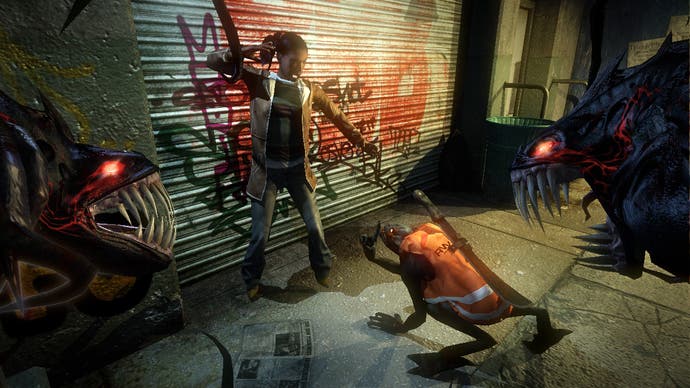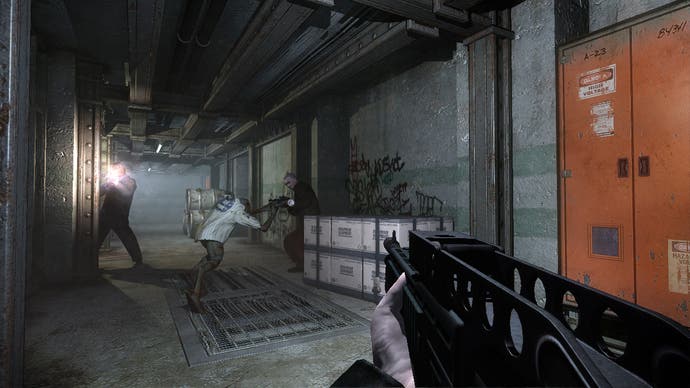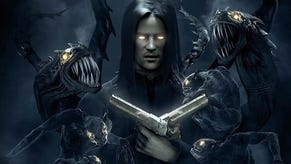The Darkness
Day of the tentacles.
I'm facing a bit of a dilemma, dear readers. You see, beloved colleague Rob Fahey got a bit carried away when he wrote the first impressions piece of The Darkness. He liked it so much, he not only played it all the way through (all 15 hours), but he detailed almost every interesting feature in-depth, told us about the excellent narrative and back-story, the tentacle-waving combat, and the darkness powers and summed up by saying the game was a "fascinating prospect" that any fan of first-person shooters or horror games should buy. Lucky for us we don't pay by the hour.
So what's left for me to say other than slap a deservingly high score on the end and expand on the online multiplayer side of the game? Fortunately for you, review fans, a fair bit.
There are things about The Darkness that will have you gurning with frothing appreciation and leave you in no doubt that Starbreeze is among the most talented developers in the world. Its ability to consistently inject new life into a resolutely tired genre shouldn't be underestimated. Just as Starbreeze managed with The Chronicles of Riddick: Escape from Butcher Bay, the pacing's exquisite in that the game twists and turns in new directions just when it's required.
As soon as you settle into a groove, a new darkness power unlocks and offers a new dimension to the gameplay, or a new type of darkling is made available to you. Far from being yet another corridor shooter to yawn your way through, it's a game that gives you a great deal of choice, and no set solution to get there. For example, rather like how FEAR gave players the option of whether to use time-slowing abilities or not (and an Achievement for those who didn't use them), The Darkness has a similar dynamic. The fact it's not a mandatory requirement opens up the gameplay variety considerably.

In my case, I preferred to use the more stealthy Creeping Dark ability. Sending out one of your tentacles slithering ahead on a scouting mission, it lets you creep up on unsuspecting sentries, snap your slavering jaws in their shocked face and rip their still beating hearts out in a flash. Other players might prefer more traditional options such as using the regular tactical rifles and dual pistols and test themselves that way, or try and sneak up on enemies and pull off grisly close-quarter moves. There's no hard and fast route to success, and the game's all the better for letting players decide what kind of anti-hero they want to be.
Of course, you also gain access to four types of Darkling along the way. These scrawny little imps can run ahead into battle for you, taking out the lights, acting as a gunner, a suicide bomber, or just a general nuisance. On rare occasions they help solve puzzles for you, although giving you an example would give you too much of a clue, so I'll resist that particular temptation.
As you'll no doubt know by now, taking out any lights in your immediate vicinity is a key requirement if you fancy using your darkness powers to full effect, but also one that makes the approach to most combat situations a rather methodical process - maybe too methodical for some. Although I liked this more slow-paced, patient approach to the combat, others might see this as a bad thing. Having to pick off every sodding light bulb and strip light before you can reliably engage in full-power combat might irk players who prefer to just wade in all guns blazing, so it's worth bearing that in mind. It's not a game for everyone, but don't take that as a negative.

As Rob explained in his preview, the game's central hub is - for the most part - set around two underground stations in New York, with all the major locations available via the station exits. In common with Riddick, this gives Starbreeze a logical link point to some of the main mission areas, as well as a much-needed sense of freedom to wander around and do your own thing when you feel the need. And if you're ever lost, or in doubt of where to go next, the status screen and various helpful terminals dotted around the station make some otherwise frustrating navigation a piece of cake. And even when you get to your destination, various street maps on the side of the road ensure you'll never be wandering aimlessly - something that games risk doing as soon as they take the linear guard rail off the level design. It's as if Starbreeze identified all the little things that could prove an annoyance and took care of them in as unobtrusive a way as possible. The game never patronises you by barking at you for going the 'wrong' way, but the minute you do get lost in the gloomy streets of Lower East Side you don't have to do much to get back on track.
That said, the sections of the game where you travel to the 'otherworld' at times display ill-advised design that feels like the polar opposite of the well-thought-out New York environment. As a concept, the otherworld is a chillingly wonderful nightmare World War, with harrowing trenches filled with zombie Germans on one side, and literally stitched together British on the other, seemingly fighting a war they can never win or lose. As horribly atmospheric as these sections are, they just don't work as well as New York: all too often it's rather too easy to stray off-course and wonder if you're doing the right thing or walking the right way. The often featureless, murky and fog-ridden landscape might well do a good job of giving the impression of one man's hell, but playing within it is the game's undoubted low-point - like Max Payne's interminable dream sequences.




